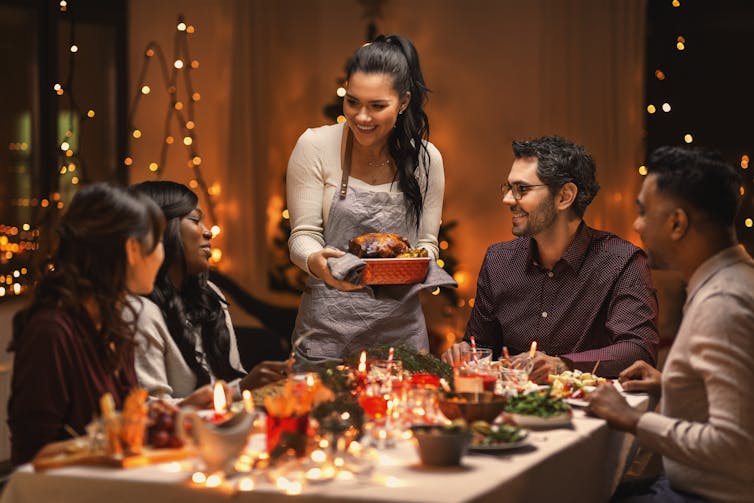Australians are expected to spend more this Christmas than last, with spending projected to rise to A$69.7 billion. This is a 2.7% increase on what we spent last year on gifts, food and other treats for ourselves and others.
This is a lot at a time when many people are experiencing mortgage stress and high inflation. But by employing smart budgeting and spending strategies we can enjoy a festive Christmas season without huge financial stress.
Know how much you are spending
Being aware of what you are spending is important. So you don’t spend beyond your means, you need to decide what you are going to buy and track what you spend.
Using budgeting tools in your banking app will help you monitor your spending. Your bank’s app or a variety of budgeting apps, can also help you find deals and stick to your financial goals.
Research shows spending decreases when you use an online budgeting app by 15%.
Christmas budgeting means setting clear limits, like a gift allowance for each person of, for example, under $10, $25, $50 or $100. This helps us stay on track. Before shopping, we should also ask ourselves: “Is this worth buying?” or “Do I really need this?”.
How to bag a bargain
About 63% of Australian consumers say they start their shopping in November, before the last-minute push to fill the Christmas stockings. This enables them to take advantage of the Black Friday sales on now and Cyber Monday, next Monday.
Online research can uncover decent bargains to lower Christmas spending. Or you could wait until the Boxing Day sales to buy discounted gifts for people you don’t see until after December 25.
The post-Christmas sales are also good for stocking up on heavily discounted crackers and decorations for next year.
Most Australian shoppers (89%) are combining online (websites, mobile apps, social media) with physical in-store shopping. Major online retailers such as Amazon, eBay, and The Iconic (69%) are now more popular than department stores (59%).
There are also thrift and discount stores which offer affordable gifts while using their income to help those in need.
By using the internet to compare prices and set price alerts for goods you want to buy, you are more likely to get the best deals. Take time to search for store discounts. Using loyalty programs, coupons, promo codes, and free shipping also helps keep money in your pocket.
Why cash at Christmas is better
The federal government’s decision last week to require businesses to accept cash, not just credit or debit cards, also has benefits for saving. Cash purchases encourage you to spend wisely, set your spending limit, and prevent you from overspending, or paying interest and fees on cards.
There is also the old “cash envelope system” used for centuries and popularised in the 1990s to help curb spending. This sees cash divided into envelopes, each labelled for a specific expense (for example, gifts for A, B, C). Once the money in the envelope is gone, nothing more can be spent.
One way to help boost your Christmas budget; while simultaneously decluttering, your home is to sell items you no longer use. There are numerous online sites and bricks and mortar stores where this can be done.
Saving money with DIY
In 2024, Australians will spend an average of $660 per shopper on gifts, with popular choices including clothing and shoes, books, and gift cards.
However, it’s not necessary to buy all your gifts or Christmas decorations. Consider making affordable handmade gifts to add a personal touch. There are demonstration videos online showing you how to re-purpose old items, bake homemade festive treats, create a special moments photo album or scrapbook.
Mix Epsom salts, essential oils and dried flowers to create relaxing bath salts or scrubs. Use natural pine cones or salt dough to make ornaments. Make wreaths using pine branches, holly or dried oranges. Sew fabric garlands to place on the tree, fireplace or mantle.
Instead of buying multiple extravagant presents for each person, try doing a Secret Santa. This is the low-cost tradition where everyone buys only one gift for one recipient who is chosen using an online tool. Gifts are then given anonymously.
Festive food
Festive food spending is projected to be $28 billion, up 4.2%, this year, contributing to the overall increase in expected total Christmas spending.
Christmas meals can be expensive but there are cheaper options. Ground Picture/Shutterstock
To save on food expenses, asks guests to bring a dish to share. Or celebrate Christmas with an economical picnic or BBQ, weather permitting.
Get creative with food leftovers to make meals and reduce the amount of food waste, while stretching your wallet further once Christmas has come and gone.
Managing costs, avoiding debt
Sticking to your Christmas budget can feel rewarding. If you do overspend, reflect on why, and adjust your plan. If needed, explore debt options, like credit cards or personal loans, but only as a last resort.
Thoughtful planning will help you manage your costs, while enjoying the festive season. After all, the true spirit of Christmas is about creating memories and enjoying time with loved ones, not about overspending.



 Every generation thinks they had it the toughest, but for Gen Z, they’re probably right
Every generation thinks they had it the toughest, but for Gen Z, they’re probably right  Canada’s local food system faces major roadblocks without urgent policy changes
Canada’s local food system faces major roadblocks without urgent policy changes  6 simple questions to tell if a ‘finfluencer’ is more flash than cash
6 simple questions to tell if a ‘finfluencer’ is more flash than cash  Fed Near Neutral Signals Caution Ahead, Shifting Focus to Fixed Income in 2026
Fed Near Neutral Signals Caution Ahead, Shifting Focus to Fixed Income in 2026  Why have so few atrocities ever been recognised as genocide?
Why have so few atrocities ever been recognised as genocide?  Youth are charting new freshwater futures by learning from the water on the water
Youth are charting new freshwater futures by learning from the water on the water  Disaster or digital spectacle? The dangers of using floods to create social media content
Disaster or digital spectacle? The dangers of using floods to create social media content 

































